Introduction
- The software architecture of any system is mainly influenced by extra-functional, or non functional, qualities
- How to express the qualities we want our architecture to provide?
- What does it mean to say that a system is modifiable or reliable or secure
Functionality vs Quality Attributes
Functionality and architectural qualities are orthogonal
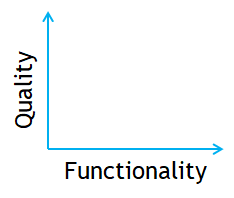
Some important qualities
- Usability
- Modifiability
- Performance
- Security
- Testability
- Availability
- Time to market
- Cost and benefit
- Projected System lifetime
- Targeted Market
- Rollout Schedule
- Integration / Legacy
Some qualities are architectural
- Conceptual Integrity the design is coherent
- Correctness the design is correct wrt to the requirements
- Completeness the design covers all the requirements
- Flexibility the design supports future changes to its requirements
- Reusability the design uses existing assets
- Buildability the design is realistic and suitable for its context
Qualities and trade-offs
- The qualities are all good
- The value of a quality is project specific
- The qualities are not independent
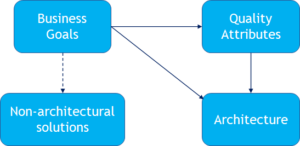
Quality Attribute Scenario
- Source of stimulus
- Stimulus
- Environment
- Artifact
- Response
- Response measure
In the environment, the source throws the stimulus and hits the system in the artifact
IMPORTANT
- One stimulus per scenario
- One environment per scenario
- One artifact per scenario
- Multiple response measures are OK
Qualities must be testable
To be effective, quality attribute scenarios must be testable (just like any other requirement)
Therefore, the following items must be clear and specific
- Stimulus
- Artifact
- Environment
- Response measure(s)
Different quality attributes
- Modifiability is about the cost of change, both in time and money. Performance is about timeliness. Events occur and the system must respond in a timely fashion.
- Testability refers to the ease with which the software can be made to demonstrate its faults or lack thereof. To be testable the system must control inputs and be able to observe outputs
- Maintainability is the ease with which a product can be maintained in order to isolate and correct defects, prevent unexpected breakdowns, meet new requirements
- Usability is how easy it is for the user to accomplish tasks and what support the
- system provides for the user to accomplish this. Dimensions: Learning system features
- Using the system efficiently
- Minimizing the impact of errors
- Adapting the system to the user’s needs
- Increasing confidence and satisfaction
- Availability is concerned with system failure and duration of system failures. System failure means un-readiness for correct service, when the system does not provide the service for which it was intended
- Reliability: the ability of a system or component to function under stated conditions for a specified period of time (=continuity of correct service)
- Dependability: availability + reliability + maintainability Safety absence of catastrophic consequences on the users or the environment
- Security is the ability of the system to prevent or resist unauthorized access while providing access to legitimate users. An attack is an attempt to breach security
Quality Attributes Types
- System Qualities
- Business Qualities
- Architecture Qualities
System Qualities
System Quality Scenarios
- Availability Scenario
- Modifiability Scenario
- Performance Scenario
- Security Scenario
- Testability Scenario
- Usability Scenario
- Scalability Scenario
- Portability Scenario
Availability
- “What’s the probability that the system works when I need it?”
- Concerns: mean time to failure
- fault detection
- repair time
- fault masking
- ..
availability = mean time to failure / (mean time to failure + mean time to repair)

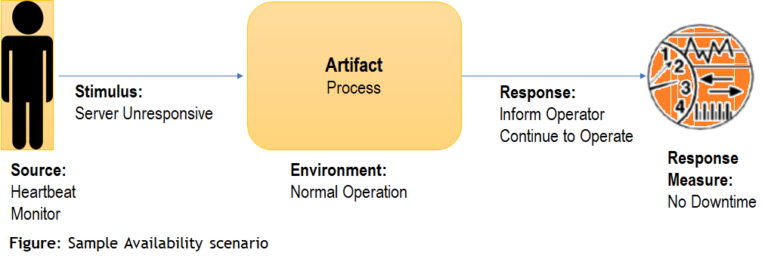
| Source | Stimulus | Environment | Response | Measure |
| Fault: | detect failure and do one or more of: | |||
| Internal to system | Crash | Normal operation | Prevent the failure | Time interval available |
| External to system | Omission | Startup | Log the failure | Availability % |
| Timing | Shutdown | Notify users/operators | Detection time | |
| No response | Repair mode | Disable source of failure | Repair time | |
| Incorrect response | Degraded (failsafe) mode | Temporarily unavailable | Degraded mode time interval | |
| Overload protection | Continue (normal/degraded) | Unavailability time interval |
Modifiability
- What can change?
- platforms
- environment
- requirements:
- performance
- reliability
- capacity
- When is the change made?
Reinstallation, plug-in, configuration, platform change.
General Modifiability Scenario

Sample Modifiability Scenario

| Source | Stimulus | Environment | Response | Measure |
| Add/delete/modify: | costs | |||
| End user | Functionality | Runtime | Make modification | Cost in effort |
| Developer | Quality attribute | Compile time | Test modification | Cost in money |
| System administrator | Capacity or technology | Build time | Deploy modification | Cost in time |
| Initiation time | Cost in number, size, complexity of affected artifacts | |||
| Design time | Extent affects other system functions or qualities | |||
| New defects introduced |
Performance
- Timing in the system
- Response time
General Modifiability Scenario

Sample Modifiability Scenario

| Source | Stimulus | Environment | Response | Measure |
| arrival of | ||||
| Internal to the system | Periodic events | Normal mode | Process events | Latency |
| External to the system | Sprodaic events | Overload mode | Change levels of service | Deadline |
| Bursty events | Reduced capacity mode | Throughput | ||
| Stochatics events | Emergency mode | Jitter | ||
| Peak mode | Miss rate | |||
| Data loss |
Security
To resist unauthorized usage:
attack:
• access to data
• access to system service
• hinder normal system operation
General Security Scenario

Sample Security Scenario
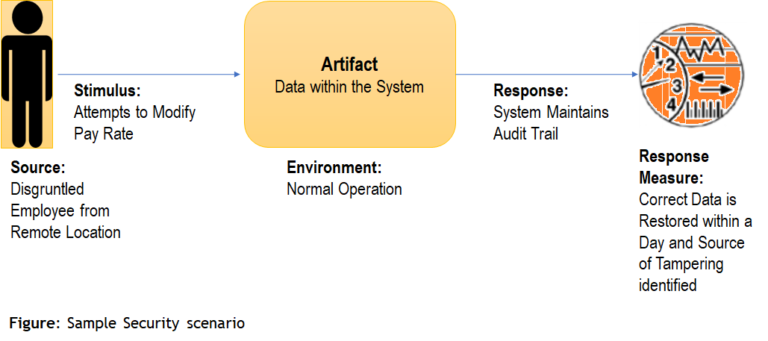
| Source | Stimulus | Environment | Response | Measure |
| Identified user or system | Attempt to display data | Normal mode | Process events | Latency |
| Unknown user or system | Attempt to delete data | Overlaod mode | Change level of service | Deadline |
| Hacker from outside the organization | Attempt to modify data | Reduced capacity mode | authenticates the user | Throughput |
| Hacker from inside the organization | Access system services | Emergency mode | hides identity of the user | Jitter |
| authorized – not authorized | Change system’s behavior | Peak mode | blocks access to data/services | Miss rate |
| access to – limited resources – vast resources | Reduce system availability | online – offline | Data loss | |
| connected – disconnected | effort to circumvent security | |||
| firewall or open | probability of attack detection |
Testability
- How easy will it be to test the system “40% of system cost use to be testing”
- How likely to find and eliminate errors
General Testability Scenario

Sample Testability Scenario

| Source | Stimulus | Environment | Response | Measure |
| Unit tester | Execution of tests due to completion code increment | Design time | Execute test suite & capture results | Effort to find fault |
| System tester | Development time | Capture causes of fault | Effort to achieve coverage % | |
| Integration tester | Compile time | Control & monitor state of the system | Probability to fault being revealed in next test | |
| Acceptance tester | Integration time | Time to perform tests | ||
| End user | Deployment time | Efforts to detect faults | ||
| Automated testing tools | Runtime | Length of longest dependency chain | ||
| Time to prepare test environment | ||||
| Reduction in risk exposure |
Usability
- How to learn to use the system
- How to use the system efficiently
- Minimize the impact of user error
- System adaptability to user needs.
- User confidence
General Usability Scenario

Sample Usability Scenario
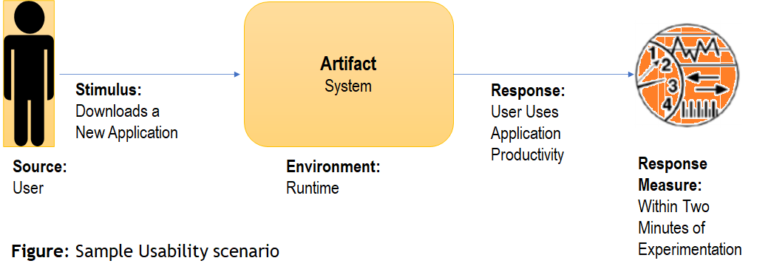
| Source | Stimulus | Environment | Response | Measure |
| wants to | ||||
| End user (possibly special role) | Use the system efficiently | Runtime | Provide features needed | Task time |
| Learn to use the system | Configuration time | Anticipate the user’s needs | Number of errors | |
| Minimize impact of errors | to support learning help system .. | Number of task accomplished | ||
| Adapt the system | to support efficient use – aggregation of commands/data – reuse of entered data/command | User satisfaction | ||
| Configure the system | to minimize impacts of errors -undo /cancel /recovery / recognition of user error .. | Gain of user knowledge | ||
| User feels comfortable | to adapt system – customizability | Ratio of successful operation to total operations | ||
| to feel comfortable – display system state | Amount of time/data lost when error occurs |
Scalability
Portability
Business Qualities
- Time to market
- Cost and benefit
- Projected system lifetime
- Targeted market
- Rollout schedule
- Integration with legacy systems
Architectural Qualities
- Conceptual integrity
- Correctness and completeness
- Buildability